European vehicle ports sail into the light

After years of overall decline, this year’s survey reveals a sense that Europe’s ports are prepared to engage competitively as automotive trade recovers.
Although vehicles sales have been in broad decline for the past half-decade, European markets remain markedly diverse. This is evident in the vehicle throughput across the roughly 40 ports participating in our annual survey, which found noticeable growth for UK ports (trade for which is up more than 8%), strong exports from Spanish ports (up more than 9%), while German harbours stagnated and French, Italian and eastern European ports saw drops.
Now, with the worst of the economic crisis potentially behind Europe, ports are looking once again at expanding their infrastructure to offer greater capacity and smoother throughput, as well as competitive inland connections.
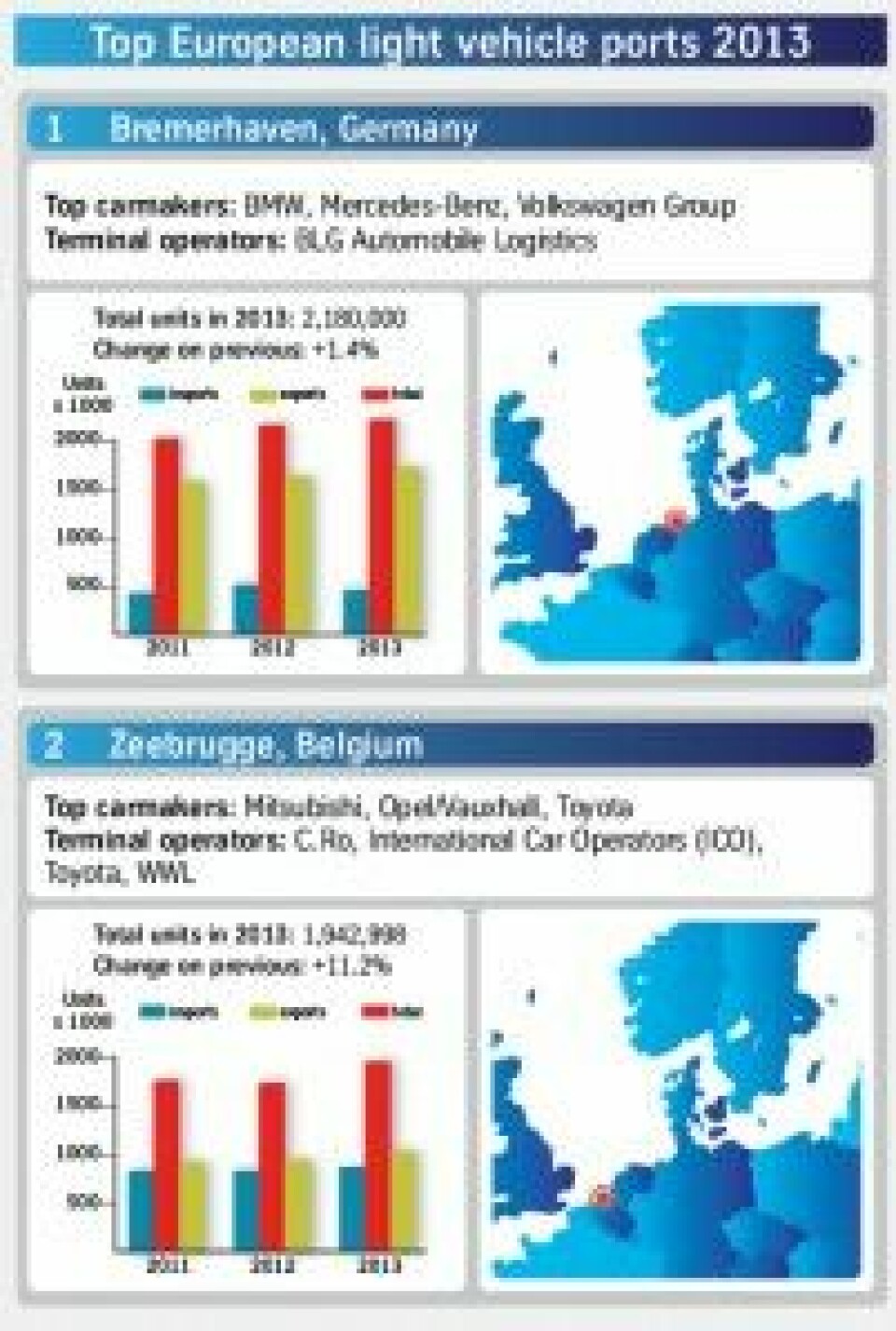
Although there is some modest hope for volumes, terminal operators, shipping lines and manufacturers are still not having an easy time of it in Europe. The volume shifts of the last few years have led to highly imbalanced flows – Spanish ports now export more than three vehicles for every one imported. Following a 12% drop in imports last year, German ports face a similar imbalance. Furthermore, upcoming changes in sulphur emission restrictions are also bound to cause some changes in port usage.
Staying ahead in a changing northern Europe
The port of Bremerhaven (pictured above) was again Europe’s leading vehicle port in 2013, handling 2.18m units, which was a slight increase over the previous year. Wolfgang Stöver, director of marketing and sales at BLG AutoTerminal Bremerhaven, says the port is experiencing a strong push in exports, with the strongest growth to the US and China.
Stöver expects imports to stagnate again this year and exports to grow by 4-6%, further compounding an imbalance of more than 3.5 exports for each import at Bremerhaven. The port’s transhipments to Russia also started declining early last year as the Russian market slowed and they remain weak. “The port landscape is changing in Europe. Among the main trends is the production shift from Western Europe to Spain, such as [from] Ford’s plant in Genk, Belgium at the end of last year,” says Stöver. “Some General Motor’s production that was built in South Korea will also be built in Spain.”
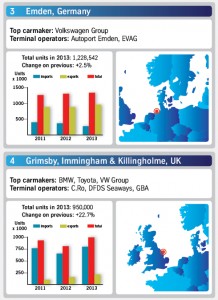
Some similar shifts could be seen at the port of Emden last year; Joerg Tuitjer, head of division automotive at terminal operator EVAG, says the port experienced a decline in imports of about 24% due to the production of the VW Golf Estate that formerly shipped to Europe via Emden, but is now produced in Germany.
Among BLG’s challenges at Bremerhaven is that vessels are arriving in clusters more often. “Our customers want to reduce their dwell time, so that is a problem,” says Stöver. “For example, cars may arrive and sit in port for five days before export. OEMs are adjusting their production to accommodate this.”
He adds that Bremerhaven is working on improving its rail infrastructure, partly in response to truck shortages, as well as long distance connections, such as to the Mercedes-Benz plant 1,400km away in Kecskemét, Hungary. BLG is also opening a new marshalling yard this year.
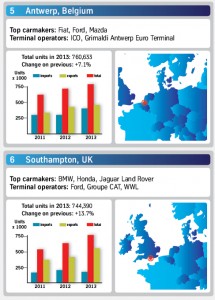
Europe’s second-largest vehicle port, Zeebrugge, which handled 1.94m vehicles last year, has experienced rising exports to the UK, Russia and the US, as well as more imports from Mediterranean countries. On the other hand, its volumes to Scandinavia, the Middle East and the Far East are declining, said Joachim Coens, chairman and managing director.
International Car Operators (ICO) operates terminals at the ports of Zeebrugge and Antwerp. Managing director Marc Adriansens says that last year, Mazda and Suzuki began using Zeebrugge to ship to Scandinavia and Russia. Suzuki also changed from Bremerhaven to Zeebrugge. Mazda had previously used long-distance rail for some of its vehicles from Japan, but switched to Antwerp for 60% and Zeebrugge for 40% of its 160,000 vehicle imports last year. Renault vehicles from Spain and Dacia models from Morocco also began using Zeebrugge to ship to Scandinavia and Russia. This past February, Nissan switched from using France’s Le Havre to Zeebrugge for imports from the UK, including PDI for French and Benelux markets. Adriansens expects Zeebrugge’s volumes to grow by 10% this year.
A new IT system was introduced in Antwerp in 2012 and in Zeebrugge last August. “Our new terminal operating system makes every vehicle visible to

customs, port processors and others from the point of vessel arrival to when a vehicle leaves the terminal,” he says, adding that statuses are now shown in real time. An ‘E-Gate’ system also provides truckers with a code to locate which vehicles to pick up or deliver. The waiting time has been cut in half to 40 minutes.
ICO built a new PDI centre last July for Renault Nissan at Zeebrugge to handle vehicles from Morocco and Spain. This year it is also building a new terminal next to Toyota’s, which will open in July, with space for 6,000-7,000 cars.
Trond Sjursen, head of region, Europe, for short-sea shipping line EML predicts that carmakers will further diversify their ports in northern Europe. “Bremerhaven had sort of a monopoly on north Europe,” he says. “Vehicle manufacturers will now have more flexibility. Volkswagen will start using Zeebrugge because of space problems and so will Daimler. OEMs are accelerating and are more flexible in how they route their shipments. For example, they may say they are planning to move from Europe to India in four or five months and ask that we accommodate them.”
The port of Antwerp’s business development co-ordinator, Ann De Smet, says its exports to China and Brazil increased the most last year thanks to fast-growing markets. Antwerp has also been experiencing higher exports of new cars to West Africa. “As for import growth, Mazda launched some new models that have sold quite well and imports from North America and Turkey have also increased,” says De Smet. “As the US market continues to recover, and with the prospect of a free trade agreement with Europe, we hope to see further increase in that trade.”

Spanish exports rising
Export growth from Spain has been perhaps the most noticeable development among European ports in our survey. At the northern port of Santander, for example, exports for Renault and Volkswagen have grown strongly, according to ro-ro traffic manager Patricio Arrarte. During the past year, the port increased its deep-sea shipment frequency to North and Central America, South Africa, Australia and New Zealand, while its short-sea connections expanded throughout Europe. Santander’s throughput grew by more than 17% in 2013 to nearly 310,000 units. Arrarte predicts a 15% increase in exports for 2014 and a 5% increase in imports.
“Our rail blocks to and from the port are now 530 metres in length and we are moving toward our goal of 700 metres. This increase enables us to optimise our rail resources and reduce costs for our customers,” says Arrarte.
United European Car Carriers (UECC) began a new weekly service that connects the port of Rotterdam to the Spanish ports of Pasajes and Santander. Sjors Bosvelt, general manager of terminal operator Broekman Car Handling, based at Rotterdam, says the port’s vehicle imports from Spain increased, as did high-and-heavy cargo. [sam_ad id=6 codes='true']
Spanish carmaker Seat uses the port of Barcelona, which is located 40km from its Martorell plant. Barcelona also provides feeder services to other ports, especially to Emden, used by the Volkswagen Group, for transhipment to deep-sea vessels. Manuel Medina, manager of finished vehicle distribution says the imbalance of flows is an issue and he would like to look at further inland connections.

“The imbalance in the volume of exports and imports of finished cars in Spain’s flows is a challenge. Thus, the port’s hinterland is important because it could attract flows from Central Europe for deliveries to overseas markets, and help to compensate this imbalance,” says Medina. “In fact, we are using maritime transport for our exports to inland destinations in Germany, Belgium and the Netherlands as feeder services to generate transhipment from other ports.”
Medina says Seat is using the full capacity of its shuttle train from Martorell to Barcelona port – three daily trips – and it uses truck services for the extra volume. “The efficiency of our suppliers has been critical, including port terminal management and flexibility of shipping companies to provide, not only our capacity needs, but also frequency. This enables us to minimise the volume of cars waiting for transport and reduce pressure on stock in the pipeline,” says Medina.
Seat’s second-largest port is Santander, from which it serves deep-sea destinations and Ireland. Traffic through this port has increased from several hundred units up to more than 7,000 in 2013, according to Medina. He says cars manufactured under the Seat brand at other Volkswagen Group plants are using the ports of Setubal (Portugal), Emden, and Koper (Slovenia). The carmaker also ships Audi cars manufactured at the Martorell plant.
“In terms of destinations, the opening of the external port at Grimsby [in the UK] is very significant. This new infrastructure should enable us to utilise this port in order to access the central UK market more efficiently,” says Medina.
The rail links in Spain
The Mediterranean port of Barcelona added three car carrier berths within the past year. Lluis Paris, commercial manager, says the port has new rail connections that run directly to the terminal, which enable the handling of trains up to 630 metres with the possibility of sectioning 750-metre trains. “New cargo buffers, which are near the car terminals, enable a more efficient rail operation,” he says. “These facilities neighbour our current car terminals, enlarging the new car handling area. The larger space dedicated now to cars and the new berths are making vessel turnaround time much smoother than in the past,” says Paris.
Barcelona experienced a 27% growth in exports to Algeria, Tunisia and Morocco last year, along with more trade to the Middle East and Turkey. The port’s exports to the Far East are also growing, including a 23% increase to China. Closer to home, exports to the UK grew by about 15% last year. By contrast, movement to North America and Oceania declined.
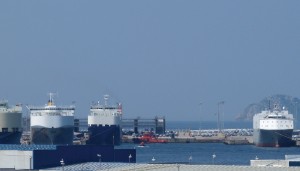
Imports from Morocco increased by 24% – mainly from Renault’s plant near Tangier – along with strong increases from France. Asian imports declined by 15%.
Jorge Civera Perez, head of technical sales at the port of Valencia, says it received its first rail shipment last year, which will improve its competitiveness for serving carmakers in Spain. Civera Perez expects consumption rates to take some time to recover, thus he expects a very slight growth in import volumes this year. For its exports, Valencia expects to consolidate its growth trend.
At the port of Vigo, which ranked as the largest Spanish port for vehicle volumes in 2013, traffic increased by nearly 15% last year, including transhipment. According to commercial manager, Dolores Rois Orza, Tunisia, Israel, Turkey, Chile and Russia accounted for the biggest increases in exports. The port has new trade lanes with Tunisia, Poland, and Sweden thanks to export increases from Peugeot Citroën, which Rois Orza expects will continue this year.
Among its recent developments, Vigo has proposed a mobile ramp as an extension of a fixed ramp at its Bouzas Terminal for loading intermodal transport units onto ro-ro vessels as a means of speeding up operations. “This will be part of the Motorways of the Sea programme between Vigo and Nantes, France, which is also supported by existing road traffic,” says Rois Orza.

The British exception
While Spain’s increases were primarily exports, in the UK growth was brisk for both exports and imports (including transhipment), reflecting the fact that the UK was the only European market to show substantial growth in vehicle sales last year. UECC’s Bjorn Svenningsen, head of car transport sales, pointed to Spain-UK trade as an exception to an otherwise tough year for Western European vehicle trade. “We boosted our sailing frequency from Santander, from two-to-three times per week to three-to-four per week to the continent and the UK,” says Svenningsen.
Joerg Tuitjer says the port of Emden’s exports to the UK increased by about 17% to nearly 428,000 units in 2013.
Indeed, our survey revealed that the UK has moved closer to Germany in terms of overall vehicle trade at its sea ports, handling around 3.64m vehicles compared to Germany’s 3.77m, including transhipment.
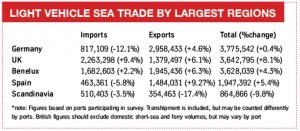
Our survey is not a definitive account of all seaborne trade. There are certainly a number of smaller ports missing in all countries (including in Scotland, Wales and Northern Ireland in the UK), while London may have been under estimated. But there is a clear trend upwards for UK vehicle flows.
As a result of this growth, many UK ports are in the midst of important expansions, including Southampton in the south of England, and the Humberside ports of Grimsby, Immingham and Killingholme. However, growth was not ubiquitous for UK ports in 2013. At the port of Tyne, which handled 644,000 units, overall volumes were slightly down as exports to Europe remained weak. “Nissan exports, and Volkswagen and Audi imports remain strong,” says Alasdair Kerr, commercial director of port services.
In 2013, the Renault Nissan Alliance also made Tyne its common entry point for UK imports, including its Nissan, Infiniti, and Dacia models; Renault had previously moved via Teesport, which no longer handles vehicles.
Changes in the southeast
Despite the troubles of Greece’s economy, imports through the port of Piraeus increased by nearly 13% compared to 2012, and port authorities expect them to increase again this year. Transhipment declined by more than 4%, mostly as a result of continued political turmoil in Egypt, Libya and other parts of North Africa and the Middle East, according to Thanassis Karlis, head of strategic planning at the Piraeus Port Authority.
Last year, Piraeus expanded the storage area of its G2 Terminal to 145,000 sq.m with 1,200 metres of berth length. Karlis says the main development was the completion of a rail connection for the car terminal that connects the national and international networks that can reach central and eastern regions of Europe. The new rail connection can accommodate four rail wagon blocks of 150 metres each.
“Although still in the pilot stage, we expect it will provide advantages for vehicle imports from the Far East by reducing transit time to Central Europe by three to four days compared with the sea route around Europe,” says Karlis. In the future, it can also offer an alternative for vehicles destined to Ukraine and southern Russia by bypassing the Bosporus Strait.
UECC also experienced growth in exports from Turkish ports, where it handles vehicles for Ford, Toyota, Peugeot Citroën, Renault, and Hyundai. “The value of the Turkish lira declined late last year, which will reduce imports to Turkey this year and will increase its exports,” predicts Svenningsen.
North Africa and hub and spoke

During the past year, European ports developed stronger connections with North African ones as both production and demand increased from Europe’s southern neighbour. From its transhipment hubs at the ports of Gioia Tauro, Italy and Vigo, UECC continues to expand into North Africa, where it currently serves Algeria, Libya, and Tunisia. As the region develops, Svenningsen points out that North Africa faces both political instability as well as infrastructure deficits.
Gregor Belic, car terminal director at the port of Koper, says it established new regular lines to North Africa as well as to the port of Poti, Georgia in the Black Sea. “However, government import regulations in Libya and Algeria have led to a decline in volume,” says Belic.
The port of Koper’s imports from Korea decreased for Kia, Hyundai, and GM, partly as a result of European production from Korean brands and declining GM Chevrolet sales (which will end in central and west Europe by 2016).
“Our challenge is to establish new lines to new destinations – in particular, West Africa; Tarragona, Spain; and the Red Sea,” says Belic.
Within the past year, the port of Koper has invested in a number of improvements, including new storage areas, a drainage system and wind protection, among others.
Mitsubishi Motors Europe uses the hub ports of Zeebrugge and Bremerhaven for north Europe; Gioia Tauro and Piraeus for the south. It also uses 15 spoke ports for short-sea shipments to final destinations. Some spoke ports serve multiple countries such as the port of Derince, Turkey, which also serves Romania, Bulgaria, and Macedonia. Bas van Groenewoud, general manager, supply chain management, says Mitsubishi switched these volumes from Koper to Derince last year because it has shorter inland distances to destinations. Van Groenewoud says Mitsubishi’s import volumes are slowly increasing again thanks to the favourable exchange rate of the Japanese yen, among other factors.
“Our deep-sea carriers are calling fewer ports, which is decreasing our total transit time,” he explains. “With lower volumes, our deep-sea carriers had also been calling ports in North Africa. These ports were congested, which increased transit times. Now, the volumes for our North African destinations tranship to short-sea vessels at Piraeus.”
This change means that although the deep-sea leg is now slightly longer, the inland leg is much shorter for Mitsubishi. “Due to the shorter distance between port and final destination, there is more flexibility for local car carriers and we can reduce the total lead time,” he says.
At Gefco, Andrea Conti, director of finished vehicle logistics, says that the third party provider uses Zeebrugge to handle exports from France and other parts of west Europe to the UK and Scandinavia, as well as Asia, South Africa and North Africa. The southern port of Marseilles exports to Tunisia and Algeria; Barcelona serves South Africa. Valencia and Livorno are also hubs for imports and some exports.
Conti says that Gefco’s target for next year is to consolidate positions for its export flows. “Within the next two years, we plan to move more road transportation to sea. Rail is still rigid so it would be difficult to increase our use of rail. With sea, more capacity, flexibility and agility of the shipping lines is possible,” says Conti.
Bear market in Russia
The main Russian ports in the Baltic showed mixed results last year, with the port of St Petersburg’s volumes declining by nearly 12% compared to 2012. By contrast, at the port of Ust-Luga imports increased by nearly 15% to more than 191,000 units. Ust-Luga handles imports for Toyota, Lexus, Hyundai, Kia, Subaru, Suzuki, and Honda at its YUG-2 Terminal. Elena Kuzmina, deputy general manager of automotive logistics, says the port of Ust-Luga predicts 2014 will be challenging, most notably as a result of the recent weakening of the rouble, but she predicts an upturn by mid-year.
Among its recent developments, Kuzmina says that last year, following rail improvements, the port began land shipments to Kazakhstan. In 2013, it also began to offer different PDI services. The uprising in Ukraine in February and Russia’s involvement may have some effect on vehicle trade, but it seems that it would more likely be concentrated on the Black Sea as opposed to the Baltic Sea.

The French connection
At France’s leading vehicle port of Le Havre, terminal infrastructure increased by 18 hectares in 2013 to a total area of 100 hectares. Le Havre’s largest import increases were from Turkey, Morocco, Spain and the UK. On the export side, its focus was on the African market with a new service for second-hand vehicles. European RoRo Lines is also implementing a ro-ro platform in Gennevilliers and a main office at Le Havre to collect second-hand vehicles for transfer by barge to Le Havre and shipment to major ports in West Africa, including ones in Mauritania, Senegal, and Cote d’Ivoire, among others.
Hervé Cornède, commercial and marketing director of Haropa, which operates Le Havre together with the inland ports of Rouen and Paris, anticipates another difficult year in 2014. “But we are optimistic for the coming years. Next year will be a pivotal one for new flows for both inbound and export volumes.”
Among Le Havre’s challenges is to improve its multimodal connectivity with a new barge service between Le Havre and Paris. With its Ro-Ro Max project, Le Havre increased storage capacity, improved maritime access for round the clock operations, and improved its vessel on-time level to 98%. The ro-ro terminal connects to several multimodal distribution systems: barge, rail, and road access for finished vehicles. The port will also introduce a new paint centre in 2014, which will prepare vehicles for delivery to dealers.
European vehicle trade remains uncertain, with recent gains liable to be undermined by weakness in a number of economies, as well as the threat of turmoil at the continent’s periphery, including the Ukraine and Russia, or southern neighbours in North Africa, the Middle East and Turkey. Higher costs could also change trade patterns when the sulphur restrictions come in next year.
Nevertheless, after years in which most markets declined, many ports now look to be wading deeper into the competition for carmakers’ changing flows. Strong export links to North America and Asia are also helping to counter weakness. The waters may be choppy, but the prevailing wind seems to be blowing in the right direction.





